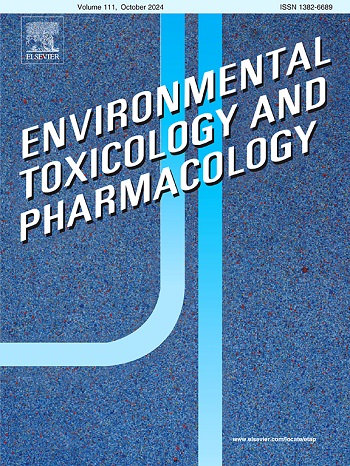Isatin-linked pyrazole K1 derivative alter the phosphatidylinositol-3-kinase pathway by enhancing the metabolic function and folliculogenesis in the triclosan-induced PCOS-like condition in zebrafish model
IF 4.2
3区 环境科学与生态学
Q2 ENVIRONMENTAL SCIENCES
引用次数: 0
Abstract
Polycystic ovarian syndrome (PCOS), which causes hormonal imbalance, inflammation, and metabolic disorders, requires several treatments. This study aimed to examine the Isatin-linked pyrazole K1 derivative's effectiveness in PCOS induced by environmental contaminants such as triclosan, specifically assessing its biochemical, metabolic, and reproductive impacts. Isatin-linked pyrazole K1 derivative was synthesised in the lab and tested in vitro and in vivo, including cytotoxicity testing in CHO cells, apoptosis analysis in AO/PI staining, and developmental toxicity in zebrafish embryos. In addition, for network pharmacology analysis, BindingDB, GeneCard, and other databases were used to characterise the interaction of K1 derivative with PCOS-related genes and pathways, followed by examining the apoptosis in CHO cells, estimation of total cholesterol and triglycerides in adipose tissue of zebrafish. Furthermore, GSI%, follicular stage examination, collagen accumulation, nucleic acid staining by toluidine blue, and gene expression of cyp19a1a, dennd1a, tox3, pik3ca, and pik3cd were examined. The research found that K1 reduces various PCOS pathologies, improving folliculogenesis, overall ovarian function, and follicular growth. K1 treatment at 25 µM significantly enhanced SOD (1.470 ± 0.01533 U/ml), CAT (1.174 ± 0.008687 U/ml), and GSH (1.375 ± 0.006409 U/ml) levels while reducing LDH activity (0.9815 ± 0.01273 nmol/mg), demonstrating its ability to mitigate oxidative stress and cellular damage. In particular, K1 modulates insulin sensitivity by reducing the blood glucose level in PCOS-induced fish and lowering lipid levels, which is essential for treating PCOS metabolic symptoms. K1 derivative also significantly reduced collagen deposition in ovarian tissues, indicating K1 may reduce PCOS-related fibrosis, which suggests that the derivative may be a novel therapeutic agent for PCOS. The comprehensive approach of K1 addresses metabolic and reproductive concerns; however, clinical studies must be conducted to test these findings' efficacy and safety and understand its therapeutic molecular processes.
Isatin-linked pyrazole K1衍生物通过增强三氯生诱导的pcos样斑马鱼模型的代谢功能和卵泡生成,改变磷脂酰肌醇-3激酶途径
多囊卵巢综合征(PCOS)会导致激素失衡、炎症和代谢紊乱,需要几种治疗方法。本研究旨在研究istin -linked pyrazole K1衍生物对三氯生等环境污染物诱导的PCOS的有效性,特别是评估其生化、代谢和生殖影响。在实验室合成了Isatin-linked pyrazole K1衍生物,并在体外和体内进行了测试,包括CHO细胞的细胞毒性测试,AO/PI染色的凋亡分析,以及斑马鱼胚胎的发育毒性。此外,通过BindingDB、GeneCard等数据库进行网络药理学分析,表征K1衍生物与pcos相关基因和通路的相互作用,检测CHO细胞的凋亡情况,估计斑马鱼脂肪组织中总胆固醇和甘油三酯的含量。检测GSI%、卵泡分期、胶原积累、甲苯胺蓝核酸染色、cyp19a1a、dennd1a、tox3、pik3ca、pik3cd基因表达。研究发现,K1可减少各种PCOS病理,改善卵泡生成、卵巢整体功能和卵泡生长。K1治疗25 µM显著提高SOD(1.470 ± 0.01533 U /毫升),猫(1.174 ± 0.008687 U /毫升),以及谷胱甘肽(1.375 ± 0.006409 U /毫升)水平,同时减少LDH活性(0.9815 ± 0.01273 nmol /毫克),证明它能够减轻氧化应激和细胞损伤。特别是,K1通过降低PCOS诱导鱼类的血糖水平和降低脂质水平来调节胰岛素敏感性,这对治疗PCOS代谢症状至关重要。K1衍生物还能显著减少卵巢组织中的胶原沉积,提示K1可能减少PCOS相关纤维化,提示该衍生物可能是一种新的PCOS治疗剂。K1的综合方法解决了代谢和生殖问题;然而,必须进行临床研究来检验这些发现的有效性和安全性,并了解其治疗分子过程。
本文章由计算机程序翻译,如有差异,请以英文原文为准。
求助全文
约1分钟内获得全文
求助全文
来源期刊
CiteScore
7.00
自引率
4.70%
发文量
185
审稿时长
34 days
期刊介绍:
Environmental Toxicology and Pharmacology publishes the results of studies concerning toxic and pharmacological effects of (human and veterinary) drugs and of environmental contaminants in animals and man.
Areas of special interest are: molecular mechanisms of toxicity, biotransformation and toxicokinetics (including toxicokinetic modelling), molecular, biochemical and physiological mechanisms explaining differences in sensitivity between species and individuals, the characterisation of pathophysiological models and mechanisms involved in the development of effects and the identification of biological markers that can be used to study exposure and effects in man and animals.
In addition to full length papers, short communications, full-length reviews and mini-reviews, Environmental Toxicology and Pharmacology will publish in depth assessments of special problem areas. The latter publications may exceed the length of a full length paper three to fourfold. A basic requirement is that the assessments are made under the auspices of international groups of leading experts in the fields concerned. The information examined may either consist of data that were already published, or of new data that were obtained within the framework of collaborative research programmes. Provision is also made for the acceptance of minireviews on (classes of) compounds, toxicities or mechanisms, debating recent advances in rapidly developing fields that fall within the scope of the journal.

 求助内容:
求助内容: 应助结果提醒方式:
应助结果提醒方式:


